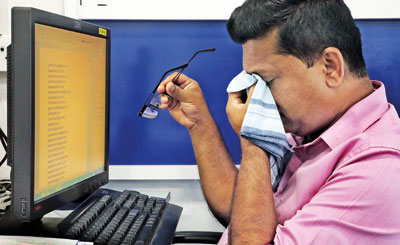That harmful gaze

Dr. Dharma Irugalbandara
Look around any place you are in……..men, women and children are ‘glued’ to some type of a screen.
It may be a tab, laptop, desktop or even a smart phone, but all are gazing intensely at a screen.
Have we thought of the impact of such screen-use on our eyes?
“When we focus our eyes for a long time on a computer or display device, a condition called Computer Vision Syndrome or Digital Eye Strain can come about,” says Consultant Ophthalmologist Dr. Dharma Irugalbandara.
Pointing out that this is due to looking at screens for “protracted, uninterrupted periods of time” which leads to the eye muscles facing an inability to recover from the strain, she says that there could be eye discomfort and vision problems.
“The more you keep looking at a digital screen, the higher the level of discomfort,” says Dr. Irugalbandara.
The most common symptoms of Computer Vision Syndrome are:
- Eyestrain
- Headaches
- Blurred vision
- Dry eyes
- Neck and shoulder pain
She reiterates that some of these symptoms may be aggravated by poor lighting, the glare coming off a digital screen, improper viewing distances, poor seating posture, uncorrected vision problems or a combination of these factors.
Comparing Computer Vision Syndrome to carpal tunnel syndrome and other repetitive motion conditions, Dr. Irugalbandara creates the image of a person’s eyes following the same path over and over, focusing and re-focusing constantly.
“Back and forth your eyes will travel, sometimes looking down at notes and then back again as you key-in those notes. The eyes have to deal with constantly moving and changing images, shifting focus, sending rapidly varying images to the brain,” she says stressing that this causes a lot of strain on the eye muscles. Aggravating the situation is that the screen brings on contrast, flicker and glare.
It is totally different to when we read a book or piece of paper, she says, pointing out that the letters on a screen are not as precise or sharply defined while the level of contrast of the letters to the background is reduced, and there is also glare and reflections on the screen.
“A person staring at a screen also blinks far less frequently (usually we blink about 15-20 times per minute), leading to the eyes drying out and the vision getting blurred on and off. It is when we blink that the tears get spread out over the eyes. Age also makes matters worse, as after 40, the ability to focus on near and far objects decline (presbyopia),” adds Dr. Irugalbandara.
This is while minor vision problems adding discomfort to the screen-user, it is learnt.

Staring at the screen puts a strain on the eye muscle. Pic by M.A. Pushpa Kumara
Sometimes, we tend to tilt our heads or bend toward the screen to see it better. These changes in our postures cause spasms in the muscle or a pain in the neck, shoulder or back, she says.
Referring to how Computer Vision Syndrome may be diagnosed, this Consultant Ophthalmologist says eye doctors will do an eye examination, after taking a detailed case history. They will check out whether the person has other health issues and what medications he/she is taking.
There will be a visual acuity measurement to determine whether the vision is affected and if so to what extent; refraction to ascertain the lens power needed to compensate for refractive errors (nearsightedness, farsightedness or astigmatism) and also tests to see how the eyes focus, move and work together.

| Children affected too The danger in children is that prolonged screen-use could cause myopia (short-sightedness) in later life, cautions Dr. Dharma Irugalbandara. Get children’s eyes checked while making sure that the computers they are using are at the right height, while having adequate lighting. Tell them to take their eyes off the computer regularly, go for a walk around the home or garden to rest the eyes, she adds.
| |
| Simple adjustmentsHaving done an extensive search on the web, Dr. Dharma Irugalbandara suggests some simple adjustments which can help people overcome Computer Vision Syndrome. They include: Setting yourself the 20-20-20 rule – Take your eyes off the screen every 20 minutes, look at an object about 20 feet away and do so for about 20 seconds. This allows your eyes to re-focus. To keep your eyes moist, you need to blink frequently. Take a longer break after two hours’ time on a screen. Position your computer right – Among the suggestions are that the computer screen should be about 25 inches, or an arm’s length, from your face, with the screen centre being about 10-15 degrees below eye level. Reduce the blue light and glare – this can be done by using a screen filter or lowering the colour of your screen. Blue light is known to cause eye-strain. The lighting in the room where the computer is matters – it should be bright and the light from the screen should not be brighter. Where to place any reference material – they should be above the keyboard and below the monitor, at the same distance from the eyes as the screen. Otherwise, use a document holder beside the monitor. This would prevent the constant turning of the neck and eyes from the screen to the document. How to sit before the computer — The height of the seat of the chair should be in a position to allow you to rest your feet flat on the floor. If there are chair-arms, they should support your arms while typing. Your back should be straight and resting on the chair-back. |


